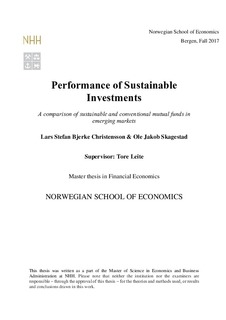| dc.description.abstract | This thesis compares the performance and risk factor exposure of sustainable and conventional
mutual funds in emerging markets from January 2012 to July 2017. We use the latest
sustainability ratings provided by Morningstar to define sustainable funds, and apply CAPM,
Fama-French and Carhart models to control for the market, size, book-to-market and
momentum factors. Additionally, we add a dummy to compare the risk-adjusted returns of the
funds, and examine if the difference is statistically significant. To expand our understanding
of the funds’ performance and behavior we study them during three different economic cycles:
Steady development, Recession and Recovery. The results imply there is no statistically
significant difference in risk-adjusted returns between sustainable and conventional funds.
However, conventional funds tend to outperform sustainable funds during recovery periods.
Further, we discover sustainable funds being less exposed to the market and small companies,
with difference in exposure to the market only present during the recession period. The
difference in exposure towards small companies is consistent during both the steady and the
recession period, but we reveal sustainable funds to exhibit a greater exposure to small
companies than conventional funds in the recovery period. Our findings suggest there is no
additional cost related to investing sustainable in emerging markets, except when the economy
is recovering from a recession. | nb_NO |
